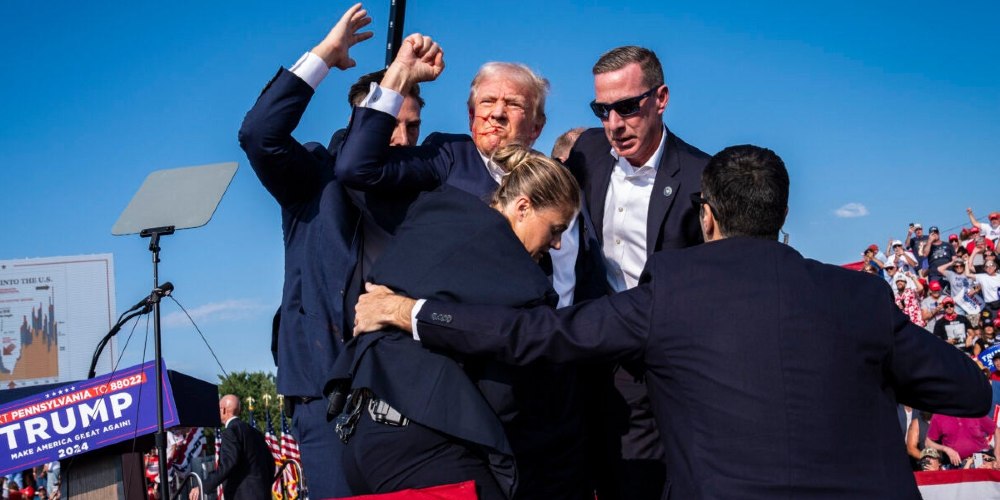(The Daily Signal)—The Secret Service missed several opportunities to stop the first attempted assassination of former President Donald Trump in July, according to a Senate report released a day after the second such attempt on Trump’s life at his golf club in Florida.
Sen. Josh Hawley, R-Mo., released a 22-page report Monday that says the Department of Homeland Security, the Secret Service, and the FBI all failed to answer the public’s questions about the first attempted assassination of Trump on July13 during a campaign rally in Butler, Pennsylvania.
“In response, Senator Hawley personally visited the Butler, Pennsylvania rally site to interview whistleblowers, opened up a whistleblower tip line, and encouraged those with relevant information to tell their stories,” the Hawley report says. “Since then, many individuals have come forward with information regarding the events of July 13—from the Secret Service, DHS, and local law enforcement, as well as private citizens.”
The Secret Service contends that it is working with members of Congress on oversight of the July 13 shooting, which clipped Trump’s right ear, killed one rallygoer, and wounded two others.
“The U.S. Secret Service is aware of the senator’s report and will continue to work with congressional oversight committees in both the House and the Senate,” Secret Service spokesperson Nate Herring told The Daily Signal in an email responding to an inquiry about the Hawley report.
Here are top takeaways from the new report on the attempt to kill Trump in Pennsylvania.
1. ‘Gunman Would Have Been Handcuffed in the Parking Lot’
The Secret Service’s Counter Surveillance Division didn’t perform a normal evaluation of the Butler site, the whistleblower alleged. The division performs threat assessments of event sites involving protectees.
“The whistleblower stated that if personnel from CSD had been present at the rally, the gunman would have been handcuffed in the parking lot after being spotted with a rangefinder,” the report says.
The whistleblower said the Secret Service had ordered significant cuts to the division that could include reducing manpower by up to 20%.
Secret Service personnel also expressed alarm that individuals were admitted to the Pennsylvania rally without vetting. The whistleblower alleged that those who raised such concerns faced retaliation.
2. ‘Former President, and Not the Incumbent’
The Hawley report notes that during a Senate hearing July 30, Ronald Rowe, the acting director of the Secret Service, testified: “If you’re talking about Butler, Pennsylvania, all assets requested were approved.”
However, the whistleblower told Hawley’s office that countersniper teams and countersurveillance resources were not included in the request because Secret Service officials told the requesting agents that such requests would be denied.
The Secret Service denied the requests for additional security in part because Trump was “not the incumbent” president.
“The whistleblower alleged that officials within this office preemptively informed the Pittsburgh field office that the Butler rally was not going to receive additional security resources because Trump is a former president, and not the incumbent president or vice president,” the report says.
The whistleblower said the manpower request didn’t include extra security resources because agents on the ground were told not to ask for them in the first place, according to the report.
“Importantly, these resources included countersniper teams and CSD personnel,” the report says.
Members of Congress have questioned why Trump didn’t have more protection after the first assassination attempt July 13.
On Sunday, Palm Beach County Sheriff Ric Bradshaw told reporters that since Trump isn’t a sitting president, Secret Service coverage was limited.
“If he was [the sitting president], we would have had this entire golf course surrounded,” Bradshaw said.
During a Monday afternoon press conference, Rowe talked about both the July and September attempts on Trump’s life.
“Coming out of Butler, I have ordered a paradigm shift,” Rowe said during a press conference Monday. “The Secret Service’s protective methodologies work. And they are sound. And we saw that yesterday. But the way we are positioned right now in this dynamic threat environment, it has given me guidance to say, ‘you know what, we need to look at what our protective methodology is.’ We need to get out of a reactive model and get to a preparedness model.”
3. ‘Known to Be Incompetent’
One whistleblower asserted that the Secret Service agent in charge of the Butler rally was responsible for mitigating line-of-sight concerns at the site.
Another whistleblower alleged the same lead agent at the rally made decisions that “likely compromised the overall security of the event.”
“The Secret Service’s lead site agent on July 13—the agent with specific responsibility for the security of the rally site, including line-of-sight concerns—was known to be incompetent,” the report says. “That incompetence led to the placement of items like flags around the Butler stage and catwalk, impairing visibility.”
The report continues:
For example, campaign material such as flags were permitted to be placed around the stage and catwalk used by the former president, despite the fact that these items were typically prohibited because of how they affected the line-of-sight of those agents responsible for identifying threats.
The Secret Service also did not check IDs when issuing credentials that authorize access to restricted areas of the site, contrary to typical practice.
4. ‘Loose’ Security for Trump
The government whistleblower informed Hawley’s office that the Secret Service considered Trump’s July 13 rally a “loose” security event.
Among other things, this meant that “detection canines were not deployed to monitor entry and detect threats in the usual manner for outdoor campaign rallies,” the Hawley report says.
The report also says that individuals “without proper designations” could access backstage areas at the Pennsylvania rally.
“DHS personnel failed to properly police the 5-foot security buffer near the stage and allowed people to move barricades around the buffer,” the report says, referring to the Department of Homeland Security, parent agency of the Secret Service. Further, the whistleblower said, DHS personnel were not familiar with security protocols for campaign events.
“The whistleblower further alleged that the majority of DHS personnel working the rally were agents with the department’s Homeland Security Investigations (HSI) team,” the report continues.
5. ‘Abandoned the Roof’
The whistleblower told Hawley’s office that there was supposed to be a security presence on the roof of what is called AGR Building 6, where the would-be assassin aimed and fired shots at Trump, killing one man, striking two other men, and grazing the right ear of the former president as he spoke onstage.
That rooftop was supposed to be covered by personnel, the whistleblower said, “but the post was abandoned because of the hot weather.”
During the Senate hearing July 30, Hawley questioned Rowe, the Secret Service’s acting director, about this point.
Rowe replied that law enforcement was “posted up inside” Building 6. He said “we’re going to ensure that state and local countersnipers are on roofs.”
- Gold SKYROCKETED during Trump’s first term and is poised to do it again. Find out how Genesis Precious Metals can help you secure your retirement with a proper self-directed IRA backed by physical precious metals.
Hawley pressed whether law enforcement officers had abandoned their post on the roof. Rowe replied that he did not “know that to be a fact.”
6. No Drone Coverage
On July 25, Hawley wrote a letter to Homeland Security Secretary Alejandro Mayorkas about a whistleblower allegation that drone coverage for the Trump rally had been denied by Secret Service supervisors.
The report provides more information on the matter.
“The whistleblower alleged that the night before the rally, Secret Service personnel repeatedly denied offers from a local law enforcement partner to utilize drone technology to secure the rally,” the report says. “According to the whistleblower, the drones that were offered to the Secret Service could not only identify active shooters but also help neutralize them.”
After the shooting, Secret Service personnel asked local law enforcement to deploy the drone technology to survey the site, the whistleblower told Hawley’s office.
The 20-year-old would-be assassin used his own drone to survey the rally area up to two hours before Trump took the stage.
7. ‘Poorly Secured’ Hospital
After the July 13 shooting, Secret Service agents rushed the stage to shield Trump before taking him to Butler Memorial Hospital for medical treatment.
Although the campaign rally wasn’t adequately secured, neither was the hospital, the whistleblower told Hawley’s office.
“The hospital site where former President Trump received treatment after the shooting was poorly secured, and the hospital site agent could not answer basic questions about site security,” the report says.
The report later adds: “The Secret Service site agent responsible for hospital security did not know what was going on and could not answer basic questions about site security.”
- Gold SKYROCKETED during Trump’s first term and is poised to do it again. Find out how Genesis Precious Metals can help you secure your retirement with a proper self-directed IRA backed by physical precious metals.




